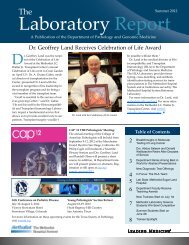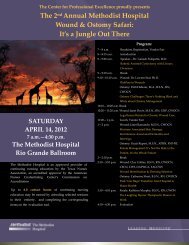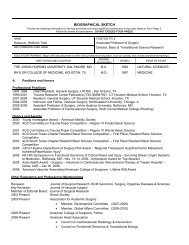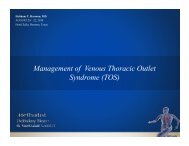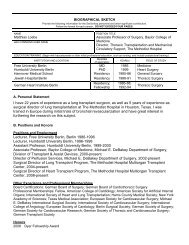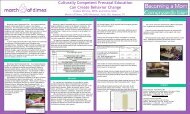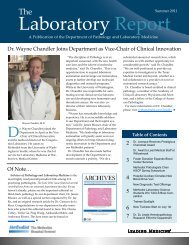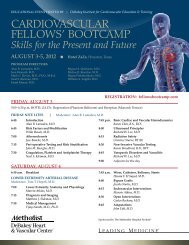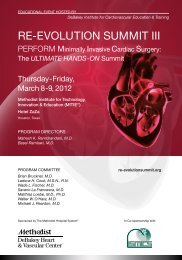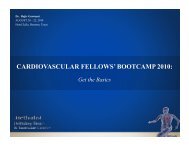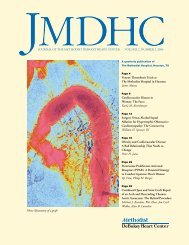DeBAKEy CARDIOvASCuLAR JOuRNAL - Methodist Hospital
DeBAKEy CARDIOvASCuLAR JOuRNAL - Methodist Hospital
DeBAKEy CARDIOvASCuLAR JOuRNAL - Methodist Hospital
Create successful ePaper yourself
Turn your PDF publications into a flip-book with our unique Google optimized e-Paper software.
As a consequence of the above work, it is now possible<br />
to bring left ventricular anatomy and function<br />
together with blood flow within large-to-medium<br />
arteries as a coherent beneficial flow system. Cardiac<br />
architecture causes the left ventricle to “wring/squeeze”<br />
the heart empty, acting as a kind of spiral-compressive<br />
pump. This ejects the blood flow from the left ventricle<br />
through a nondiseased aortic valve with a spiral laminar<br />
flow profile. This flow pattern has been shown to be<br />
preserved as it passes around the arch of the aorta and<br />
into the descending/abdominal aorta, which may in<br />
part be due to the nonplanar nature of the aortic arch.<br />
Finally, spiral laminar flow has been identified within<br />
more distal direct line vessels (femoral arteries) and<br />
branch vessels (carotid arteries). Spiral flow may also<br />
have beneficial effects on cardiac work and tissue oxygenation<br />
and in the protection of the arterial wall from<br />
atherogenesis.<br />
Clinical Correlation<br />
When assessing the significance of spiral laminar<br />
flow, it is important to show a causal relationship with<br />
the development of arterial disease. There is very little<br />
work in this area and it is more circumstantial than<br />
definitive.<br />
The loss of spiral blood flow has been associated with<br />
the presence, severity and progression of atheromatous<br />
disease. 25, 26 However, it should be stressed that this is<br />
an association and not proof of a causal relationship. A<br />
long-term mapping of flow patterns against disease and<br />
its progression is required, and this has not been performed<br />
as yet.<br />
Flow Analysis and Vascular Stents and<br />
Grafts<br />
Hemodynamic forces are a key localizing factor in<br />
arterial endothelial dysfunction and, as a result, arterial<br />
pathology. 27 Low shear stress appears to be one of the<br />
key components of this flow/vessel wall interaction. 28 In<br />
1993, Zarins et al. demonstrated that intimal thickening<br />
and atherosclerosis develop in regions of relatively low<br />
shear stress and variation from axially aligned unidirectional<br />
flow. 29 Stonebridge and Brophy hypothesized that<br />
spiral flow could exert a beneficial effect on the mechanisms<br />
of endothelial damage and repair. 19 A study by<br />
Caro et al. supported this hypothesis and demonstrated<br />
that spiral flow may lead to relative uniformity of wall<br />
shear and inhibition of flow stagnation, separation and<br />
instability. 30<br />
Spiral flow has also been shown to preserve laminar<br />
flow through stenoses (“laminar stability”), markedly<br />
Figure 4. Laminar stability — nonspiral (upper) and spiral (lower)<br />
MRI image of flow through a stenosis showing loss of image with<br />
nonspiral flow and preservation of image with spiral flow. 31<br />
reducing turbulent kinetic energy (Figure 4). It also<br />
reduces laterally directed forces impacting on the vessel<br />
wall. Spiral laminar flow generates a thin, less-dense<br />
(probably acelluar) outer shell, which may act as a “fluid<br />
bearing” for the denser inner core, again assisting in<br />
31, 32<br />
reducing rotational decay.<br />
One study investigated the magnitude of oscillating<br />
shear stress in an aortocoronary bypass computer<br />
model in the presence of spiral flow. A linear inverse<br />
relationship was found between the oscillating shear<br />
index and the helical flow index for the models. The<br />
results indicated that spiral flow damped the wall shear<br />
stress temporal gradients within the proximal graft. The<br />
authors suggested that spiral flow might play a significant<br />
role in preventing plaque deposition by moderating<br />
the mechanotransduction pathways of cells. They further<br />
concluded that the strength of the spiral flow<br />
signal could be used to risk stratify for the activation of<br />
mechanical and biological pathways leading to fibrointimal<br />
hyperplasia. 33<br />
A graft or stent that recreates spiral flow at the distal<br />
anastomosis/outflow might be anticipated to have some<br />
benefits. A numerical analysis based on a spiral flow<br />
inducer for endovascular stents showed that the inducer<br />
could create sufficiently strong spiral flow, effectively<br />
MDCvJ | vII (1) 2011 23



